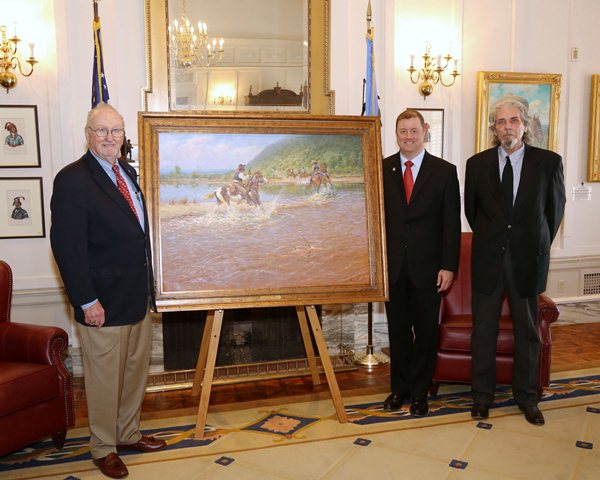In order to provide equal access and equal opportunity to people with diverse abilities, this site has been designed with accessibility in mind. Click here to view
Portrait of first African American Deputy Marshal Bass Reeves Unveiled
 Fomer state Senator and President of the Senate Historical Preservation Fund poses with sponsor Dan Newberry and artist Wayne Cooper.
Fomer state Senator and President of the Senate Historical Preservation Fund poses with sponsor Dan Newberry and artist Wayne Cooper.
The Senate unveiled a portrait Tuesday of the nation’s first African American Deputy Marshal, Bass Reeves.
Reeves was born a slave in 1838 in Crawford County, Arkansas. He worked for a prominent politician in the region and farmer, William S. Reeves, as a water boy in the cotton fields of the Reeves farm. During the Civil War, Bass was a servant for William's son, George Reeves, who was a Colonel in the Confederate Army who organized the 11th Calvary regiment. Bass claimed to have fought in several battles but because of a dispute with George, he allegedly escaped and fled into the Indian Territory (now known as Oklahoma) as a fugitive slave. There he associated with Native Americans from the Creek and Seminole tribes learning their language and customs.
Bass eventually moved to Arkansas where he met his wife Nellie Jennie and raised their ten children. Refining his skills as an outdoorsman, Bass became an expert sharpshooter. In addition to earning a living as a farmer, rancher and a horse breeder, he also served as a guide into the Indian Territory for Deputy U.S. Marshals for the Van Buren federal court searching for outlaws. In 1875, the legendary “Hanging Judge” Isaac C. Parker was appointed a federal judge of the Indian Territory. Parker appointed James Fagan as U.S. Marshal and instructed him to hire 200 deputy marshals. Knowing of Reeves' reputation with a pistol, his ability to speak several Indian languages and interact with them as well as his knowledge of the territory, Fagan named Reeves a Deputy Marshal, the first African American to hold the title.
Reeves became one of the most feared and respected U.S. Marshals in Indian Territory. He arrested some of the most dangerous criminals of the time. During his 32 years as a federal peace officer, he arrested 3,000 felons and killed 14 outlaws defending his life during arrests. He was a legend in Indian Territory and was one of Judge Parker’s most valued deputies. The fact that Reeves was an African American who had spent his early life as a slave in Arkansas and Texas makes his accomplishments all the more remarkable.
He was the only deputy to begin with Parker's court and work until Oklahoma statehood in 1907. After retiring from federal service, Reeves joined the Muskogee Police Department at the age of 68. Unfortunately, in 1910, his health deteriorated and he died of Bright’s disease.
Reeves is considered by many scholars to be one of the most outstanding frontier heroes in U.S. history.
The portrait is by artist Wayne Cooper and is his twentieth piece to be displayed at the state Capitol. It is sponsored by Sen. Dan and Laura Newberry, TTCU The Credit Union, WEOKIE Credit Union, Communication Federal Credit Union, Bison Federal Credit Union, Green Country, Federal Credit Union, Oklahoma Central Credit Union, and Truity Credit Union. It is a project of the Oklahoma State Senate Historical Preservation Fund.
 Oklahoma Senate
Oklahoma Senate

